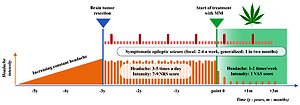CASE REPORT
Significant reduction of symptomatic headache by medical marijuana – Case report
1
Department of Medical Chemistry, Medical University, Lublin, Poland
2
Terapie Cannabium, Lublin, Poland
Corresponding author
Jacek Kurzepa
Department of Medical Chemistry, Medical University, Chodzki 4a, 20-093 Lublin, Poland
Department of Medical Chemistry, Medical University, Chodzki 4a, 20-093 Lublin, Poland
J Pre Clin Clin Res. 2021;15(4):162-164
KEYWORDS
TOPICS
ABSTRACT
Despite the limited number of large clinical trials on the positive therapeutic effect of medical marijuana, the several thousand-year history of using cannabis in medicine and numerous reports allow the conclusion that cannabis preparations have a great therapeutic potential. The report presents the clinical case of a 35-year-old female patient treated with medical marijuana preparations due to persistent headache following neurosurgical resection of a brain tumour. Therapy with medical marijuana was started 3 years after surgery. Headache occurred several times a day and responded poorly to NSAIDs, which resulted in the patient often giving-up pharmacological treatment. The applied treatment with dried cannabis with high THC content taken by vaporization in a finally dose of 0.1 g twice a day showed a significant reduction in pain by 7–9 on the NRS within the 3 months of therapy. This observation suggests a significant analgesic effect of cannabis in the treatment of symptomatic headaches.
Kurzepa J, Wezgraj W, Luchowska-Kocot D. Significant reduction of symptomatic headache by medical marijuana. Case report. J Pre-Cin Clin
Rs. 2021; 15(4): 162–164. doi: 10.26444/jpccr/142773
REFERENCES (19)
1.
Costa B, Trovato AE, Comelli F, et al. The non-psychoactive cannabis constituent cannabidiol is an orally effective therapeutic agent in rat chronic inflammatory and neuropathic pain. Eur J Pharmacol. 2007; 556: 75–83. 10.1016/j.ejphar.2006.11.006.
2.
Thomas A, Baillie GL, Phillips AM, et al. Cannabidiol displays unexpectedly high potency as an antagonist of CB1 and CB2 receptor agonists in vitro. Br J Pharmacol. 2007; 150: 613–623. 10.1038/sj.bjp.0707133.
3.
Ferber SG, Namdar D, Hen-Shoval D, et al. The “Entourage Effect”: Terpenes Coupled with Cannabinoids for the Treatment of Mood Disorders and Anxiety Disorders. Curr Neuropharmacol. 2020; 18(2): 87–96. doi: 10.2174/1570159X17666190903103923.
4.
Cogan PS. The ‘entourage effect’ or ‘hodge-podge hashish’: the questionable rebranding, marketing, and expectations of cannabis polypharmacy. Expert Rev Clin Pharmacol. 2020; 13(8): 835–845. doi: 10.1080/17512433.2020.1721281.
5.
Amin MR, Ali DW. Pharmacology of Medical Cannabis. Adv Exp Med Biol. 2019; 1162: 151–165. doi: 10.1007/978-3-030-21737-2_8.
6.
Vučković S, Srebro D, Vujović KS, et al. Cannabinoids and Pain: New Insights From Old Molecules. Front Pharmacol. 2018; 13(9):1259. doi: 10.3389/fphar.2018.01259.
7.
Lochte BC, Beletsky A, Samuel NK, Grant I. The Use of Cannabis for Headache Disorders. Cannabis Cannabinoid Res. 2017; 2(1): 61–71. doi: 10.1089/can.2016.0033.
8.
Mechtler L, Bargnes V, Hart P, et al. Medical Cannabis for Chronic Migraine: A Retrospective Review (P3.10–015). Neurology. 2019; 92: P3.10–015.
9.
Citti C, Pacchetti B, Vandelli MA, et al. Analysis of cannabinoids in commercial hemp seed oil and decarboxylation kinetics studies of cannabidiolic acid (CBDA). J Pharm Biomed Anal. 2018; 5; 149: 532–540. doi: 10.1016/j.jpba.2017.11.044. Epub 2017 Nov 20.
10.
Romero-Sandoval EA, Kolano AL, Alvarado-Vázquez PA. Cannabis and Cannabinoids for Chronic Pain. Curr Rheumatol Rep. 2017; 19(11): 67. doi: 10.1007/s11926-017-0693-1.
11.
Woodhams SG, Chapman V, Finn DP, et al. The cannabinoid system and pain. Neuropharmacology. 2017; 15(124): 105–120. doi: 10.1016/j.neuropharm.2017.06.015.
12.
Pergolizzi JV Jr, Lequang JA, Taylor R Jr, et al. The role of cannabinoids in pain control: the good, the bad, and the ugly. Minerva Anestesiol. 2018; 84(8): 955–969. doi: 23736/S0375-9393.18.12287-5. Epub 2018 Jan 16.
13.
Andreae MH, Carter GM, Shaparin N, et al. Inhaled Cannabis for Chronic Neuropathic Pain: A Meta-analysis of Individual Patient Data. J Pain. 2015; 16(12): 1221–1232. doi: 10.1016/j.jpain.2015.07.009.
14.
Abrams DI. The therapeutic effects of Cannabis and cannabinoids: An update from the National Academies of Sciences, Engineering and Medicine report. Eur J Intern Med. 2018; 49: 7–11. doi: 10.1016/j.ejim.2018.01.003. Epub 2018 Jan 9.
15.
Likar R, Nahler G. The use of cannabis in supportive care and treatment of brain tumor. Neurooncol Pract. 2017; 4(3): 151–160. doi: 10.1093/nop/npw027. Epub 2017 Jan 18.
16.
Ferber SG, Namdar D, Hen-Shoval D, et al. The “Entourage Effect”: Terpenes Coupled with Cannabinoids for the Treatment of Mood Disorders and Anxiety Disorders. Curr Neuropharmacol. 2020; 18(2): 87–96. doi:10.2174/1570159X17666190903103923.
17.
Rosenberg EC, Tsien RW, Whalley BJ, Devinsky O. Cannabinoids and Epilepsy. Neurotherapeutics. 2015; 12(4): 747–68. doi: 10.1007/s13311-015-0375-5.
18.
Hart S, Fischer OM, Ullrich A. Cannabinoids induce cancer cell proliferation via tumor necrosis factor alpha-converting enzyme (TACE/ADAM17)-mediated transactivation of the epidermal growth factor receptor. Cancer Res. 2004; 64(6): 1943–50. doi: 10.1158/0008-5472.can-03-3720.
19.
Galanti G, Fisher T, Kventsel I, et al. Delta 9-tetrahydrocannabinol inhibits cell cycle progression by downregulation of E2F1 in human glioblastoma multiforme cells. Acta Oncol. 2008; 47(6): 1062–70. doi: 10.1080/02841860701678787.
Share
RELATED ARTICLE
We process personal data collected when visiting the website. The function of obtaining information about users and their behavior is carried out by voluntarily entered information in forms and saving cookies in end devices. Data, including cookies, are used to provide services, improve the user experience and to analyze the traffic in accordance with the Privacy policy. Data are also collected and processed by Google Analytics tool (more).
You can change cookies settings in your browser. Restricted use of cookies in the browser configuration may affect some functionalities of the website.
You can change cookies settings in your browser. Restricted use of cookies in the browser configuration may affect some functionalities of the website.


